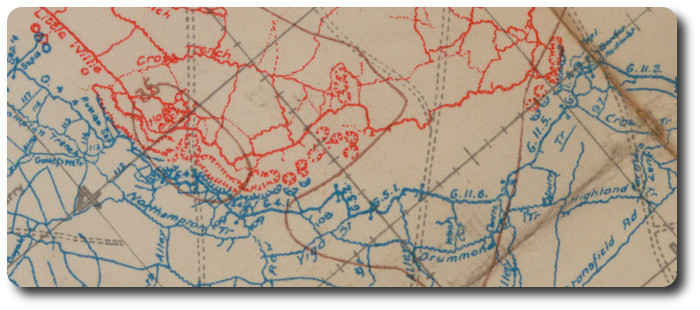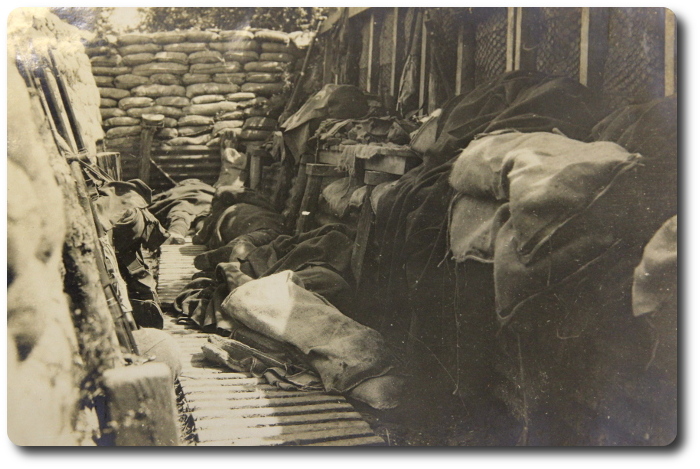Topic: CEF

At Home in a Ditch
Seeing Trenches as Soldiers See Them
Boston Evening Transcript, 9 February 1915
(From the Manchester Transcript)
I wonder how many people have a mental image of the trenches which is at all like the real thing. I have seen photographs of men standing in a trench behind a covering line of mangel wurzels, or was it beet-root?—which are true enough, but hardly characteristic. No doubt many people imagine the trenches to be a regular and formidable series of earthworks which turn a whole valley into a sort of fortress. They have heard of all sorts of elaborations which get mentioned in letters, not because they are characteristic, but just because they are peculiar. As a matter of fact, the surprising thing about the trenches is that, like everything else in this war, they make so little difference to the normal appearance of the landscape until you get quite close to them. If an invisible wayfarer could walk past them during the day he might very easily get through without noticing anything peculiar unless an artillery bombardment happened to be going on. Rifle fire and attacks are nearly all at dawn or dusk or night. He would have to be invisible, for any visible wayfarer near the trenches by day would, of course, be snipes. A few do make their way to and fro—orderlies with messages mostly, who creep along ditches and dash across exposed intervals. But the traffic is by night. Every evening a little party of men and mules goes to a point as near as it dare to the battalion and takes shelter behind a house or a wall, where it is met by one or two men of each company to take the daily rations back to the trenches.

Every evening, too, the stretcher-bearers make their way into the trenches and remove the men who have been wounded during the day. And every evening all these men are "sniped" at by the enemy as they go about their work. As you approach the trenches in the dusk the lack of anything abnormal to the whole aspect of things is, of course, even more deceptive than by day. And knowing as one does that once is within a few yards of two lines of men which extend from the sea coast to Switzerland, the blank appearance of everything is tinglingly suggestive. You are walking along an ordinary country road. You have just passed the house where the medical officer and his assistants have taken up their quarters and whence they pass on the wounded by motors to the field ambulance. A couple of days ago he had a house farther up the road, but he was shelled out of it. You pass other houses—you are walking crouched in the ditch by this time. By day you would notice that many of these houses have holes in them and that there are patches of tiles wanting in the roof; but by the evening light they look quite normal, except that the windows are lit up in none of them. Cattle and fowls wander about over the fields, and across the road. They look quite normal too, though in daylight you would see that the cows have not been milked, and the fowls are starving. By daylight, too, you might notice here and there in a field a cow that has been struck down by a shell and killed or another—poor beast—that had been merely wounded. It was to put such a one out of its pain that an officer of ours crept out of his trench the other morning and was killed as he crawled back. A little farther still you may at last come upon the trenches themselves at a point where they chance to touch the road. The reserve trenches these will probably be , and they have perhaps just been lined by a battalion that has marched out to be in support during the night in expectation of an attack and will march back before sunrise in the morning. They are, maybe, an Indian cavalry regiment which has never yet had a chance of fighting on horseback and can contribute only in this way to the defence.


From your ditch by the roadside will probably be a communications trench to the first of these reserve trenches, and from here, if the entrenchments have been in existence for some time, you will find yourself at the beginning of a whole rabbit warren. From here you may be able to get to every point, not only in the reserve trenches, but the fire trenches, too, without ever putting your head above the ground. Walking in slush (here and there modified by straw or bricks thrown down), rubbing clay onto your shoulders from either wall of the narrow passage, you may pass along a whole series of reserve trenches, which seem to be deserted unless you lift up one of the pieces of canvas fixed against the wall and see a silent Indian cavalryman curled up in his little niche. It will be for many reasons a very tortuous walk before you arrive at the fire trenches, or at the colonel's little "dug-out." First of all, because the communications trenches are planned in every sort of zigzag and curl and twist, to be as little as possible end-on to the enemy, and so enfiladed. The colonel's headquarters, for instance, is entered from the back, and approached by a trench which twists around behind it. Moreover, the line of the fire trenches is broken at intervals by traverses—also to protect against possible enfilading—and connected by little semi-circular trenches which skirt around the solid interval of earth. But the way will be tortuous for other reasons. The whole line of the two armies is tortuous beyond the suspicious of any reader who sees it twist a little along the frontier, but suppose it will be straight enough for half a mile. Losses here and gains there are partly a cause of this, but much more is the fact that the whole series of trenches is developed from a skilful use of natural conditions. Sometimes the trench is merely a ditch which has been deepened. At other times the adaptation of a pit or a hollow makes it ten feet deep, and the men have to climb up on ledge to fire out of it. Here and there the connecting trench becomes a tunnel, by having been roofed in. At other places a convenient bush or hedge affords cover which has enabled quite a little cavern to be dug under its protection.

Though the hardship is severe enough the men manage to make themselves more comfortable than might be supposed. They have charcoal braziers which help to keep them warm, and there is even talk—serious talk—of installing electric light. The adjutant has made quite a little office of his "dug-out" and pins up notes and orders and telegrams onto the clay wall in front of him. When the trenches have been in existence long enough there is communication everywhere, though it is often difficult to squeeze by, and as for sleep—well, you can take a little of that as soon as the shelling starts, for you know he will not attack till that is over. The only thing that you can hardly anywhere do is to stand up. If you try it, "ping" almost at once, and you are lucky if you only get your face spluttered with mud. And just out there—sometimes only fifty yards away—they are taking the same precautions about all of us, and peeping with the same curiosity. And between the lines is fifty yards of ordinary field where no one dare venture by day, and only at imminent danger by night, in that fifty yards is now lying one of our officers, killed in last night's attack. Tonight we hope to get him back, but today we can but peep at him. His hand is hanging down, and on his wrists is his watch. It is still going, and from where we are we can see the time.

